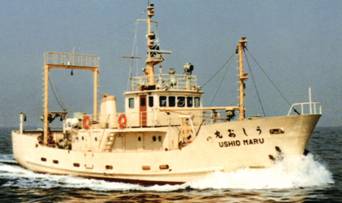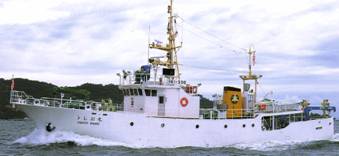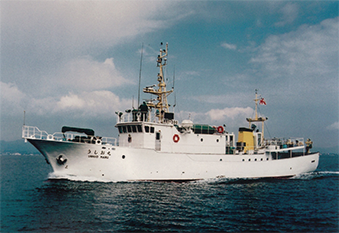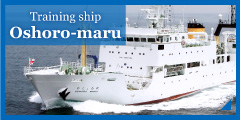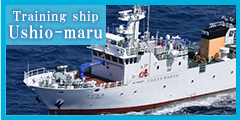Ushio-maru I
The Ushio-maru I was constructed by Nippon Kokan K.K. and Yokohama Yacht Dockyard Co., in March 1971. She was the mother ship of the “Kuroshio-II” that was a submersible vehicle for research, belonging to the Faculty of Fisheries, Hokkaido University.
She was a stern trawler equipped with 294kW main engine, a controllable pitch propeller, an anti-rolling tank and accommodations for 12 persons (crew:6p, instructors & cadets:6p). She was engaged in research work on coastal seas around the southern part of Hokkaido, involving biological, chemical and physical oceanography, as well as scientific fisheries.
Elongated Ushio-maru I
After the retirement of the submersible vehicle “Kuroshio-II” in 1978, she was converted to a research ship. In November 1981, her hull was elongated at Kantoh Kogyo Co., to fill up more crew accommodations, investigation and research equipment, etc. Gross tonnage became 107.8 tons and complement to 16 persons (crew:6p, instructors & cadets:10p)
Ushio-maru II
The Ushio-maru II was constructed by Mitsui Engineering & Shipbuilding Co., Ltd. and Sanuki Shipbuilding Co. in March 1992. She was a typical long F’cle type stern trawler equipped with 736kW main engine, a controllable pitch propeller, an anti-rolling tank and accommodations for 19 persons (crew:7p, instructors & cadets:12p). She was engaged in research and training works on coastal seas around the southern part of Hokkaido.
Elongated Ushio-maru II
The Faculty of Fisheries at Hokkaido University has long conducted fisheries research and training using three vessels: the Oshoro Maru, Hokusei Maru (now decommissioned), and Ushio Maru. In March 2002, the hull of the Ushio Maru was extended by the Kanto Kogyo Co., Ltd., to expand the onboard facilities and improve the survey and observation functions.
In March 2002, the hull of the Ushio Maru was extended, and the vessel was renovated by the Kanto Kogyo Co., Ltd., to expand the onboard facilities and improve the survey and observation functions.
The gross tonnage became 179 tons, with a complement of 33 (15 crew and 18 instructors and students).
The vessel was actively used for experiments, practical training, surveys, and research on physics, chemistry, biology, fisheries, fishing gear and methods, physiology, ecology, and fish biology in the waters around southern Hokkaido, Tsugaru Strait, Mutsu Bay, and other areas.

